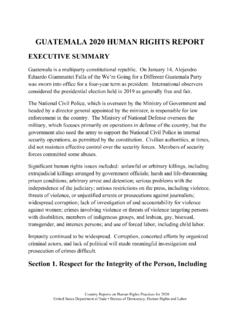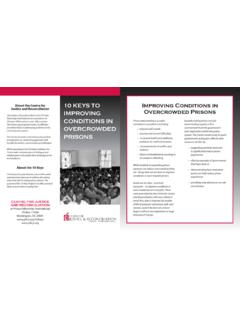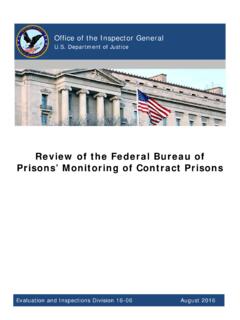Transcription of Penal Reform International Ten-Point Plan to Reduce Prison ...
1 Penal Reform International Ten-Point Plan to Reduce Prison overcrowding Introduction and can erode public confidence. In others, costly Prison -building programmes are undertaken to meet a growing demand for Prison places, which is The following plan focuses on ways of reducing sometimes stimulated further by private companies overcrowding in prisons around the world. who make profits from Prison construction and overcrowding or congestion, as it is called in some administration. countries, is the biggest single problem facing Prison systems with consequences that can at worst be life- Given the disadvantages of these approaches, PRI.
2 Threatening and at best prevent prisons from fulfilling is publishing this plan to assist policymakers and their proper function. practitioners who wish to tackle overcrowding in a systematic and affordable way. The results should There is no universally agreed definition of what help to ensure that imprisonment is only used when constitutes overcrowding but data shows that in proportionate to the offence committed and where some 117 countries the number of prisoners exceeds there are no other appropriate options, and that the number of spaces available.
3 Sixteen Prison the conditions of detention can meet the standards systems hold more than double their capacity and expected by the International community. in a further 32 countries there are occupancy rates of between 150 and 200%. Measured this way the PRI, February 2012. highest rate of overcrowding in the Americas is 335% (Haiti), in Africa 307% (Benin), in Asia 259%. (Iran), in Oceania 215% (French Polynesia), and in Europe 158% (Serbia). But overcrowding is not limited to countries whose overall Prison population exceeds capacity.
4 Particular prisons or sections of prisons can be overcrowded even if the Prison system as a whole is not. Moreover, in the absence of precise International standards, it is up to individual countries themselves to determine and sometimes revise the capacity of particular prisons. The data is therefore likely to understate the extent of the problem. The plan builds on the relevant International instruments including the UN Standard Minimum Rules for the Treatment of Prisoners, the UN. Standard Minimum Rules for Non-custodial Measures (Tokyo Rules) and the UN Rules for the Treatment of Women Prisoners and Non-custodial Measures for Women Offenders (Bangkok Rules).
5 Penal Reform International (PRI) believes that a Prison system that meets International standards is essential for the proper administration of criminal justice. Particular attention should be given to vulnerable groups who are often additionally adversely affected by the negative effects of overcrowding . Women prisoners and children deprived of their liberty are a small percentage of a country's total Prison population meaning that their specific needs tend to remain unacknowledged and unmet, which is exacerbated in overcrowded and overstretched Prison systems.
6 In some countries chronic overcrowding is relieved only by the use of periodic amnesties and pardons which, while producing short- term relief, do not provide a sustainable solution 1. Ten-Point Plan to Reduce Prison overcrowding 1. Collect and use data to 3. Divert minor cases out of the inform a rational, humane criminal justice system and cost-effective use of International standards and norms recommend Prison that resorting to prosecution and incarceration be employed only where this is proportionate to the Reducing overcrowding requires an understanding of offence committed and there are no other appropriate the extent of the problem and the reasons for which options.
7 To ensure that prisons play their proper role, it has come about in a particular Prison system. A including the role of rehabilitation, it is important that census of the Prison population can identify who is minor offences be processed in different ways. Many in Prison and why, and point to priorities for relieving countries have systems of diversion, such as police congestion. Timely and accurate information can warnings or cautions, restorative justice or mediation also enable a more rational debate about the most options, referral to mental health or drug treatment effective use of Prison and assist advocacy on behalf or prosecutorial fines.
8 Others have centuries-old of policies which meet International standards. informal processes of traditional justice which can Information-gathering and analysis should be part provide accessible and informal justice. As long as of a regular routine and the public should be kept basic human rights are observed, such processes can informed about measures which work best to Reduce have an important role to play. crime. 4. Improve access to justice 2. Review and Reform the and case management during criminal justice process pre-trial detention as a whole from arrest to release and invest in crime Countries with the highest levels of overcrowding also have Prison populations with the highest proportions prevention and reduction of pre-trial detainees.
9 In 40 countries more than half Imprisonment comes at the end of a long chain of of prisoners are held on remand. Efforts to address decisions involving legislators and policymakers, the the problem of lengthy pre-trial detention include: police, prosecutors and courts. The extent to which Prison is used reflects a range of factors including increasing legal aid and assistance and levels of inequality and investment in social policy as supplementing this by making use of paralegals well as levels of crime. Reducing Prison numbers is to provide advice to defendants.
10 Not simply a question of establishing measures which enforcing time limits in criminal proceedings;. can act as direct alternatives to pre-trial detention or sentences, although these are important. It involves offering bail and other alternatives to pre-trial the development and use of a wide range of methods detention;. to prevent crime through social and situational measures and of ways to resolve harms and disputes holding camp courts' inside prisons; and without recourse to criminal law, for example by using informal and restorative justice approaches.








